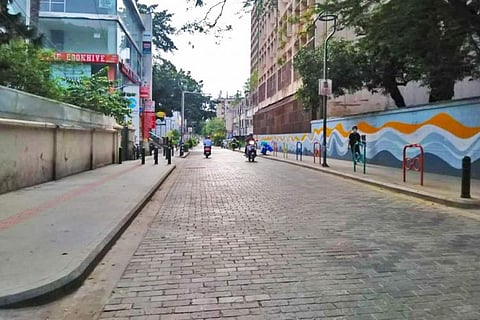

An Indian Institute of Science (IISc) study on the impact of the weekend traffic ban on Bengaluru’s Church Street in the heart of the city has found encouraging results. Not only has air quality improved due to less vehicular pollution, the traffic ban has positively impacted footfalls resulting in more business for commercial establishments. Further a slight shift towards sustainable transport modes such as bus, metro, and walking have been observed. “The outcomes of these studies suggest the importance of implementing a comfortable walking environment, protected bicycle lanes, and the ways to implement similar kinds of initiatives in other busy streets in Bengaluru to improve quality of life,” the authors of the study noted.
Piloted by the Directorate of Urban Land Transport (DULT) and IISc under the clean air initiative, starting November 6, 2020 the 750-meter-long stretch between Museum Cross Road and Brigade Road was closed off for vehicular traffic on weekends. The pilot ended on May 31 earlier this year. The study authored by professor Ashish Verma and PhD student Hemanthini Allirani of the Sustainable Transportation Lab prepared the study titled ‘Church Street First – Impact Assessment of Pedestrianising an Urban Street in terms of Quality of Life’ based on qualitative and quantitative data collected from the implementation of the vehicle ban between November 2020 to February 2021. The study has also recorded that a significant number of business owners have reacted positively towards the weekend pedestrianisation for the period.
The study relied on three air quality monitors placed on three points on the road to detect the difference of pollution levels on weekdays and weekends. “The average daily PM10 concentration for all the weekends of all months is within the CPCB limit of 100 µg/m3. The daily average PM2.5 concentration is within the CPCB limit of 60 µg/m3 for all weekends of November and February. During the last couple of weekends of December and the third weekend of January, slightly higher values are observed. However, the values are less compared to weekdays (with traffic), indicating improvement in air quality during pedestrianised weekends (without traffic).” the study said.
The study also recorded that 94% of the visitors interviewed agreed that reduced traffic noise because of a pedestrian-friendly environment improved their quality of life. The same number of people agreed that improvement in air quality due to road closure for traffic contributed to a better quality of life.
The study found that between November 2020 and February 2021, the average daily footfall on Church Street increased by 92% and the average peak duration footfall (5pm-10pm) increased by 117%. “This rise clearly shows that people became aware of the initiative that made them to visit Church Street and spend time,” the study said.
Using a video graphic survey, the study found that in total, 72,209 pedestrians visited Church Street during weekends of November and the number saw a steady rise in the coming months. Meanwhile, 82,215 persons visited the street on weekends in December, while the numbers in January and February were 1,34,706 and 1,35,540 pedestrians respectively.
“The pedestrian count has crossed 1000 in peak hour in November, 2000 in peak hour in December, 3000 in peak hour in January, and 6000 in peak hour in February, which implies people are happy about the initiative, which makes them visit the street,” the study noted.
The study noted that 35% of the shop owners agreed that pedestrianisation of Church Street resulted in an overall positive effect on their business, while 31% of shop owners agreed that the pedestrianisation of Church Street resulted in an increase in revenue. Meanwhile, 39% of the shop owners agreed that pedestrianisation of the street increased their customer footfall. Thus, within a short period of pedestrianisation, almost 35% of shop owners agreed to significant improvement in all aspects of their business activities. Nearly 35% of shop owners agreed that pedestrianisation resulted in increased customer footfall and revenue at shops, thus, enhancing their economic activity.
As a ripple effect of better pedestrian facilities and the traffic ban on weekends, there was a 7% decrease in the mode share of personal modes and an equal 7% increase in the mode share of sustainable modes among the visitors. Similarly, a 15% decrease in mode share of personal modes and 11% increase in mode share of sustainable modes was observed among shop owners after pedestrianisation.
“The number of metro users at MG Road metro station on weekends saw an increase of 162% between November 2020 to February 2021, clearly showing the positive impact of pedestrianisation on metro ridership,” the study noted. There was similar but less prominent growth in usage of bus stops at Bowring Hospital.